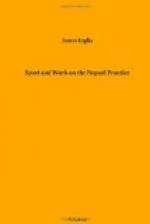You know how full of melody is an English wood, when thrush, blackbird, mavis, linnet, and a thousand warblers flit from tree to tree. How the choir rings out its full anthem of sweetest sound, till every bush and tree seems a centre of sweet strains, soft, low, liquid trills, and full ripe gushes of melody and song. But it is not thus in an Indian forest. There are actually few birds. As you brush through the long grass and trample the tangled undergrowth, putting aside the sprawling branches, or dodging under the pliant arms of the creepers, you may flush a black or grey partridge, raise a covey of quail, or startle a quiet family party of peafowl, but there are no sweet singers flitting about to make the vaulted arcades of the forest echo to their music.
The hornbill darts with a succession of long bounding flights from one tall tree to another. The large woodpecker taps a hollow tree close by, his gorgeous plumage glistening like a mimic rainbow in the sun. A flight of green parrots sweep screaming above your head, the golden oriole or mango bird, the koel, with here and there a red-tufted bulbul, make a faint attempt at a chirrup; but as a rule the deep silence is unbroken, save by the melancholy hoot of some blinking owl, and the soft monotonous coo of the ringdove or the green pigeon. The exquisite honey-sucker, as delicately formed as the petal of a fairy flower, flits noiselessly about from blossom to blossom. The natives call it the ‘Muddpenah’ or drinker of honey. There are innumerable butterflies of graceful shape and gorgeous colours; what few birds there are have beautiful plumage; there is a faint rustle of leaves, a faint, far hum of insect life; but it feels so silent, so unlike the woods at home. You are oppressed by the solemn stillness, and feel almost nervous as you push warily along, for at any moment a leopard, wolf, or hyena may get up before you, or you may disturb the siesta of a sounder of pig, or a herd of deer.
Up in those forests on the borders of Nepaul, which are called the morung, there are a great many varieties of parrot, all of them very beautiful. There is first the common green parrot, with a red beak, and a circle of salmon-coloured feathers round its neck; they are very noisy and destructive, and flock together to the fields where they do great damage to the crops. The lutkun sooga is an exquisitely-coloured bird, about the size of a sparrow. The ghur[=a]l, a large red and green parrot, with a crimson beak. The tota a yellowish-green colour, and the male with a breast as red as blood; they call it the amereet bhela. Another lovely little parrot, the taeteea sooga, has a green body, red head, and black throat; but the most showy and brilliant of all the tribe is the putsoogee. The body is a rich living green, red wings, yellow beak, and black throat; there is a tuft of vivid red as a topknot, and the tail is a brilliant blue; the under feathers of the tail being a pure snowy white.




